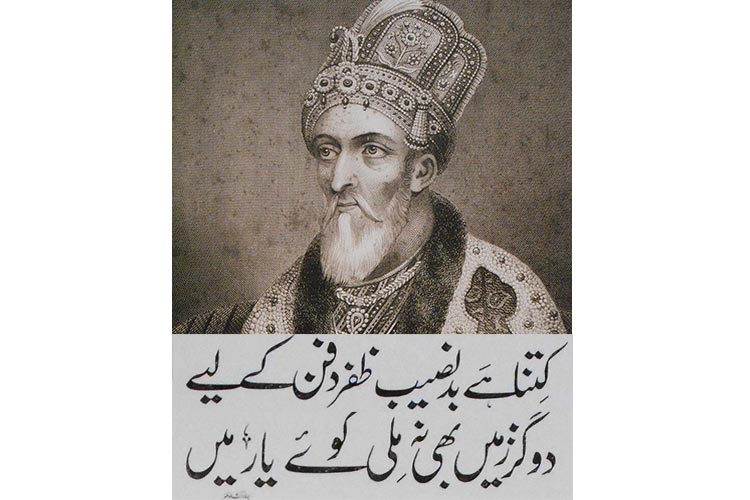Written by: Mahnaz Shujrah
Posted on: September 03, 2018 |  | 中文
| 中文
The fall of Delhi
History, arts and culture enthusiasts in Lahore have a lot to look forward to this week, with an exhibition titled "The Hollow Crown" in town. The exhibition focuses on archives from 1857-1858, showcasing the decline and end of the Mughal Empire. The exhibition formally opened on Thursday, 30th August and will be on display till Saturday, 8th September. The exhibition has been set up within Anarkali's tomb, which is in the Civil Secretariat.
The initiative is part of the Digitization Project by the Punjab Archives Department and Punjab Information Technology Board (PITB), and it aims to incorporate technology in the preservation and accessibility of history. The Centre for Governance and Policy (CGP) and Information Technology University (ITU) have also played key roles in bringing the project to life. The Hollow Crown is the second exhibition in the series, continuing on the theme of events from 1857.
The exhibits were displayed chronologically around the main circular hall of Anarkali's tomb. While the British East India Company had been ruling since 1757, Bahadur Shah Zafar, had remained the Emperor of India. It was only after the War of Independence of 1857 failed, that India was formally annexed by Queen Victoria, and became an official part of the British Empire. The events incorporated began from the British assembling troops in Punjab in May 1857 and concluded on the royal proclamation by Queen Victoria on November 1st, 1858. There were a total of nine separate exhibits, and each included a painting showcasing the event, primary documents that were exchanged at the time, and poetry from famous poets who either foresaw or witnessed the fall of Delhi.
In the words of Director Archives Abbas Chughtai, “Through a mix of text, visuals and poetry, this exhibit showcases the turbulent times during the Revolt of 1857, which finally led to the downfall of the Mughal dynasty. The visuals of a forlorn Bahadur Shah Zafar, the depravations in Delhi by the British, and the sad laments of poets like Ghalib, Momin and Zafar himself, all sketch the rueful picture of a pitiful end.” The images on display were digitally enlarged copies of paintings from original manuscripts, which were displayed in a showcase near the entrance. There were also translated copies of the primary source documents, which the audience could collect at the entrance, along with a brochure containing the timeline of events. The staff, including people who have worked on the project, were also present to guide the audience and answer questions.
At the entrance of the tomb, there was a note by the Director of Centre for Governance and Policy (CGP), Dr. Yaqoob Khan Bangash, which briefly touched upon the context and methodology of the exhibition. “Central to the exhibition are the original documents from the Mutiny and Delhi Residency papers housed at the Punjab Archives in Lahore. These documents include original telegrams concerning troop movements, the attack on Delhi, the capture of the Mughal King and the process through which Bahadur Shah Zafar and his family was tried, convicted and sentenced. These documents not only tell the story of the events of 1857-1858 from primary sources but also showcase the role of the Punjab in the saga, where Muslim and Sikh troops from the Punjab were at the forefront of the British attack on Delhi [...] The importance and role of local collaborators, is therefore central to the story of the demise of the Mughal Empire."
In the center of the room were two exhibits, one of Bahadur Shah Zafar and one of Queen Victoria. The former included original documents on the treatment of the King and his family, while the latter showcased the final Royal Proclamation by the Queen and a couplet by Ghalib. The Mughal Empire, which ruled for over 300 years, was one of the strongest empires in the world. However, the process of its decline was painful and sad. Bahadur Shah Zafar, along with the royal family, was captured on 20th September, 1857. Two days later, he surrendered. There was a trial set up to determine his fate, and in October, 1858, he along with his wife Zinat Mahal and their son Jiwan Bakht, were made to leave Delhi for Calcutta. Soon upon their arrival, they were sent to Rangoon, where the last of the Mughal emperors died a few years later, at the age of 87. Many of his other children and grandchildren were shot or sentenced to death.
Bahadur Shah Zafar had an interest in Urdu poetry, and to this day many of his poems remain well-known. The couplet above his image, written by him, had a strong impact on the audience:

Here, khoo-e-yar (street where the beloved lives), is a metaphor for all of Hindustan, which was once ruled by him, yet where he did not have the privilege to die and be buried. Adding to the sense of loss, was the sound of famous singers like Mehdi Hassan presenting renditions of his poetry, playing in the background.
The fact that the exhibition took place at Anarkali's tomb added another dimension to it. The cenotaph in the tomb was originally placed in the center, but after the British took over and turned the building into a church, they moved the cenotaph to the side. Later, the building was also used as a library and currently serves as the archives. Thus, the tomb has also witnessed the changes brought about by the British.
Overall, The Hollow Crown engages individuals through providing access to primary sources, enabling visitors to understand and analyze events at a deeper level. Most importantly, it sparks curiosity within the younger generations about history, by utilizing appealing audio-visual techniques.
You may also like: